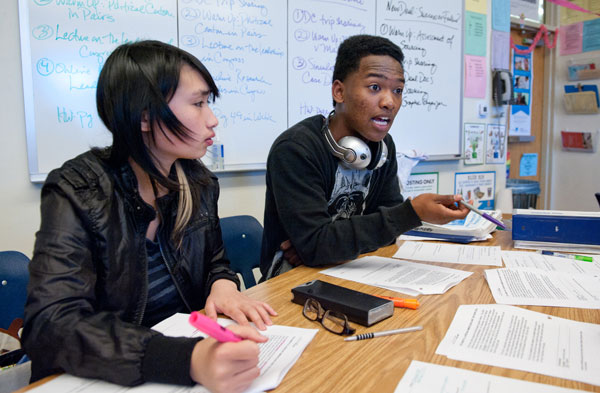Character analysis is an important skill for writers to learn. However, too often students label characters with one-dimensional terms (e.g., good, bad, funny, evil, protagonist, antagonist). Well-crafted characters are a lot like real people; they are complex. If students can understand this integral component of character analysis, they will not only be able to create vibrant characters themselves, but they will also be able to apply these skills to their daily interactions with real people.
As a means to learn these skills, I designed this lesson plan centered on vignettes. Vignettes are very short and poignant, describing a single instance of a character’s life; they are “pieces” of that life. By prompting each student to imagine and write about the same character in different facets of their identity, I invite them to explore the complexities of a character. At the end, students are able to put together all the pieces of the puzzle, revealing a completely different, richer, rounded character.
Note: I designed this lesson for two 50-minute periods, but it could be broken up and taught in three shorter periods.
Lesson Overview
Grades: 9–10
Genre: Vignette
Download: Completing the Character Puzzle with Vignettes
Common Core State Standards
- ELA-Literacy-R.L.3: Analyze how complex characters (e.g., those with multiple or conflicting motivations) develop over the course of a text, interact with other characters, and advance the plot or develop the theme.
- ELA Literacy-W.3: Write narratives to develop real or imagined experiences or events using effective technique, well-chosen details, and well-structured event sequences.
Lesson Objectives:
- Students will explain the character (Geraldo) by citing text details to support inferences.
- Students will identify the traits of a vignette.
- Students will write a vignette by applying said traits to their own work.
- Students will understand the complexities of a character.
Lesson Plan
Day One:
Warm Up (7 minutes):
- Ask students to respond to the following questions in writing:
- Have you ever felt injustice happening towards yourself?
- Have you ever felt invisible?
- Ask a few people to share their responses with the class.
Mentor Text (15 minutes):
- Begin reading the Sandra Cisneros short story “Geraldo No Last Name” by reading the first two paragraphs aloud and pointing out key details, such as “Said he worked in a restaurant” and “Green pants and Saturday shirt.” Then have students take turns reading aloud subsequent paragraphs and noting key details in what they have read.
- Lead a discussion about what the story evoked for students (e.g., images, character traits).
Introduce the Vignette (8 minutes):
- Brainstorm with students what a “vignette” could mean. Ask students to think about the differences between the elements in “Geraldo No Last Name,” a short story, and a novel. Remind students of stories and novels they have already read and discussed.
- Write the elements of a vignette on the board, making the point that a vignette is like a “snapshot” or photo of a life. Other differences from long work include the following:
- A vignette is short and describes a specific scene or event with evocative language.
- Vignettes lack a plot diagram (a clear beginning, middle, end, conflict, climax, and resolution). They may have some of these elements, but not all.
- Vignettes span a very short “story time.” Short stories and novels usually span days, weeks, months, or years. Vignettes focus and hone in on minutes or hours. As a result, they are very short.
- Vignettes provide fewer specifics about a character (e.g., age, name, appearance, clothing, race, ethnicity). We may learn some of these details, but we won’t learn them in the same depth as in a short story or novel.
- Vignettes focus on a character’s thoughts and feelings over a short span of time.
- Invite students to agree on a definition of a vignette, or provide them with a definition: A vignette is a brief and evocative description, account, or episode
Brainstorming vignettes (20 minutes):
- Introduce the writing assignment to students. Students will write their own vignettes with a keen focus on the characterization of Geraldo. The twist is, students will write a vignette on a different aspect of Geraldo’s life (working Geraldo, dancing Geraldo, eating Geraldo, family man Geraldo, etc.).
- Allow students to brainstorm which Geraldo they would like to write about. Students will then get into groups of 3-4 based on the aspect of Geraldo’s life they want to tackle.
Day Two:
Re-cap (5 minutes)
- Project the following question for students to answer in writing for about 3 minutes: What is our definition of “vignette”? What are the elements of a “vignette”?
- Ask students to share at least 3 elements of a vignette that the class discussed yesterday, and then project the definition as a reminder.
Vignette Writing Assignment (20 Minutes)
- Students will break into their groups to write their vignettes together. They are encouraged to start by jotting down an outline of their vignette, establishing and listing important details, such as setting and emotion, and the overall “moment” that is happening to Geraldo. Ideally, students will be able to work on laptops or tablets and utilize Google Classroom to collaborate on writing vignettes in a digital space.
- Walk around the room while students work to check on progress and answer questions.
Vignette Presentations (15-18 minutes)
- After they finish their vignette, give students 3–4 minutes to decide how they are going to present their vignette to the class. Then have each group present their work.
Conclusion/Wrap-up (5-7 Minutes)
- After the presentations, ask the students to piece together all of the different vignettes. How did they depict Geraldo? How did they describe him physically and mentally? What kind of life did he live? What kind of life did he live growing up compared to the life he lives now?
- End by reminding students that people are not one-dimensional and that different elements make up who they are. The same is true of strong characters in written work.
Materials:
- “Geraldo No Last Name”
- Laptops or tablets and Internet access, if possible
Photo (top) Stanford News
Jennie Weng has been an aspiring educator since she was 16 years old, the catalyst being her first job as a tutor in Chicago, her hometown. Her passion for education and writing took her to the University of Illinois at Urbana-Champaign where she majors in the teaching of English and social sciences. Weng has successfully wrapped up another semester with her fifth Dean’s List Award. Her academic drive and success have aided in her work as tutor, teaching assistant, and guest-teacher in various schools throughout the Midwest. She has even traveled to the Navajo Nation in Kayenta, Arizona, to work with students in Monument Valley High School. Weng will graduate in 2019 and hopes she will soon share her fever and passion for teaching and writing in her own high school classroom.



